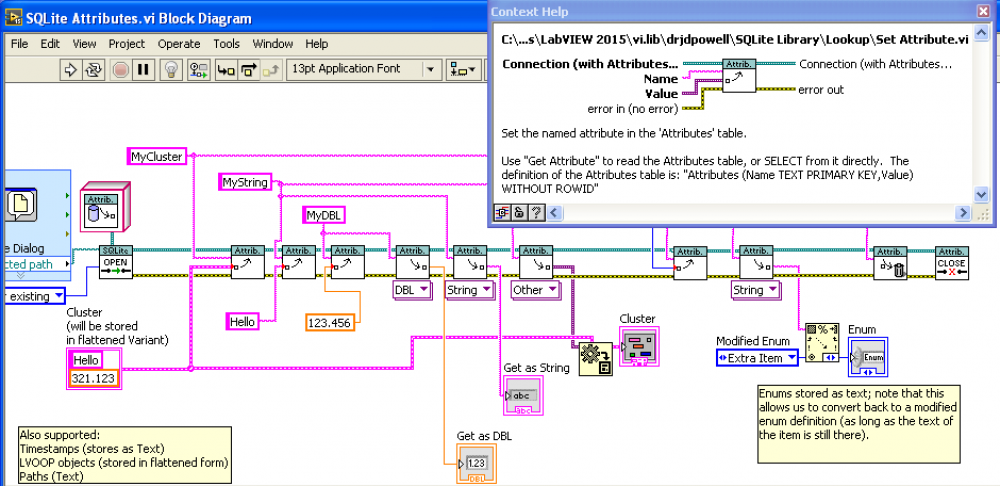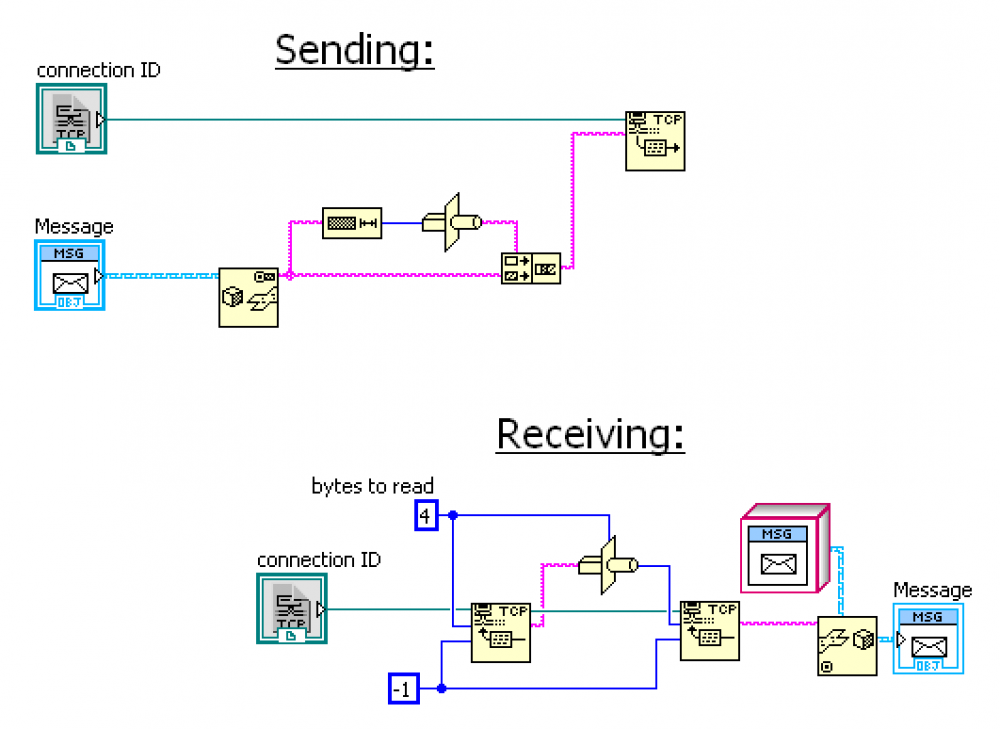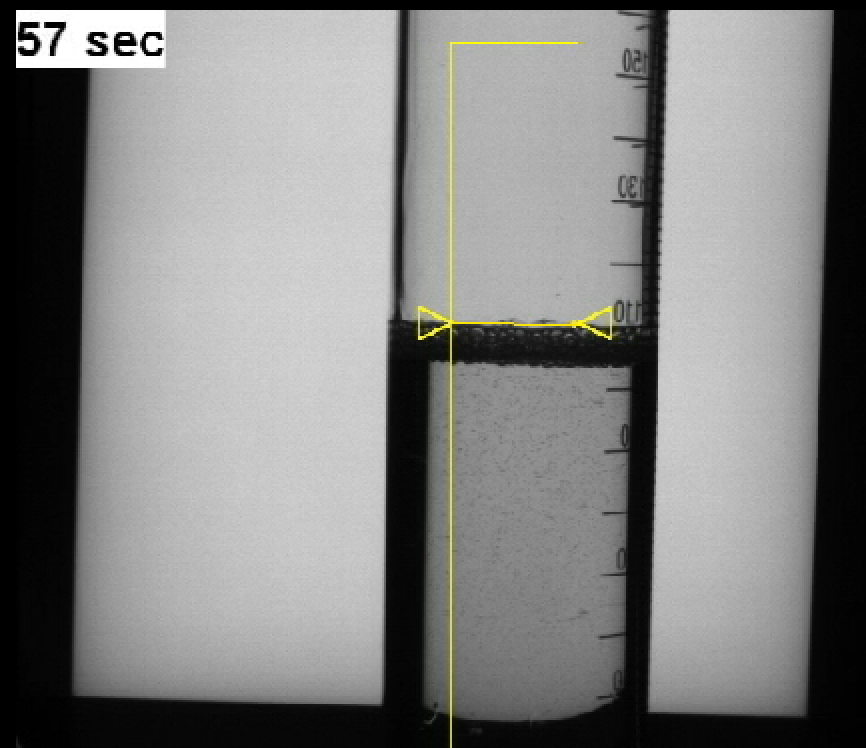-
Posts
1,986 -
Joined
-
Last visited
-
Days Won
183
Content Type
Profiles
Forums
Downloads
Gallery
Posts posted by drjdpowell
-
-
Do you see drawbacks?
Problems show up in the unflattening part. Flattening, the part you are trying, is strait forward, because you are going from strongly-typed LabVIEW to weakly-typed JSON. The other way is harder.
You don’t need to make your class a child of JSON Object; just have your class have “To JSON†and “From JSONâ€. You won’t be able to use these objects in the JSON-Variant tools, but you will be able to handle things with the other methods. This involves more coding, but is faster. And it allows one to get away from the monster config cluster and towards a distributed config, where different code modules supply different parts of the config.
-
what exactly do I have to do in order to dump my monster as json and viceversa? Create serializable.lvclas parent of all my other classes, perhaps, with two methods - doing exactly what? Is there an example?
The current JSON-Variant tools will store objects as flattened strings. Not human-readable, but flattened objects have a mutation history so you can freely rearrange things inside the class private data (but not on any condition re-namespace the class). I find that mixed-mode quite useful and easy.
Alternately, to serialize objects as JSON I usually just have methods in the class to convert to/from JSON and I use them as I build up the JSON explicitly (i.e. without using the shortcut of the JSON-Variant tools on a cluster).
There is a possibility that one could make one’s LVOOP classes children of “JSON Valueâ€, and then override “flatten†and “unflattenâ€. Then your objects would serialize to JSON even inside a cluster using the JSON-Variant tools (those tools recognize “JSON Value†objects and flatten/unflatten them). But there is a technical issue that I have to look into to make that work.[Never mind, this won’t work.]Also, suppose the monster still mutates, parameters being added or moved: what recommendations would you give in order to maximise the information which can still be retrieved from an out-of-sync configuration dump?
Adding or removing is fine, but don’t rename or move things, unless you want to have a “schema version†attribute and mutation code than coverts from older schema.
-
Ah, I see. We need something like
Error 402864, SQLITE_BUSY(5), occurred at redacted.lvlib:redacted.vi on "INSERT OR IGNORE INTO redacted ( redacted, redacted, redacted) VALUES (?, ?, ?);" Possible reason(s): database is locked. See https://www.sqlite.org/rescode.html#busy.
Edit> can’t do the above, but how about:
Error 402864 occurred at redacted.lvlib:redacted.vi on "INSERT OR IGNORE INTO redacted ( redacted, redacted, redacted) VALUES (?, ?, ?);"
Possible reason(s):
SQLITE_BUSY(5) database is locked (see https://www.sqlite.org/rescode.html) -
When throwing an error from the API, could you add the SQLite error code to the error description? My client got error 402864 last night, and it took a lot of digging to figure out what that meant. The code doesn't resolve in the Explain Error dialog, and even if it did, I'm more interested in the code returned by the sqlite3 DLL because I use that code to search their documentation when troubleshooting.
I add 402859 to the SQLite error code (apologies for that number, but those are the range of codes assigned to me by NI). I’m currently calling sqlite2_errmsg() to get an error description from the SQLite dll itself. And the message should have also contained either the database file, or SQL statement on which the error occurred. Was this information not in the error?
-
Can you add by default the function last insert rowid?
I always add this function in your API.
https://www.sqlite.org/capi3ref.html#sqlite3_last_insert_rowid
If you look in the latest beta version you’ll find it (though it’s not in the palettes, it is in the Connection class).
PS> Some notes:
— one can also use the last_row_ID() SQL function
— Be careful that you aren’t executing multiple INSERT statements in parallel on the same Connection, as you might mixup the rowIDs.
— note the existence of WITHOUT RowID tables, which avoids the need to determine the auto assigned rowID.
-
 1
1
-
-
Here is a beta version with changes aimed at performance, particularly for large arrays of data. I managed to eliminate an O(N^2) performance issue with parsing large JSON strings. I also improved the Variant tools’ speed with one- and two-dimensional arrays. See the new example “Example of an Array of XY arrays.viâ€.
lava_lib_json_api-1.4.1.33.vip
Please give this a test and let me know of any issues before I place it in the CR. I’m also thinking of submitting to the LabVIEW Tools Network.
— James
-
Is this no longer on Bitbucket? Where is the repository now?
Sorry, forgot to push the changes. It’s there now.
-
Here is a Beta version with a new “Treatment of Infinity/NaN†terminal on the JSON write functions.
Three options:
-- Default JSON: write all as nulls.
-- Extended: use JSON strings for Infinities ("Infinity", "-Infinity"); NaN still null.
-- LabVIEW extentions (compatable with the LabVIEW JSON primatives): Infinity, -Infinity, NaN (not in quotes)Note that the LabVIEW extentions are not valid JSON. The Extended option IS valid JSON, but not all JSON parsers will process strings as numeric values.
-
 1
1
-
-
There's no reason to assume any other extensions would need to be mutually exclusive from the LV numeric extensions. An enum would enforce that exclusion.
I mean alternate treatments of Inf, -Inf, and NaN. I can think of alternatives that are arguably better than the choice made in the LabVIEW primitive. Personally, I would choose NaN==Null, Inf/-Inf==“Infinityâ€/“-Infinity†(strings), as this would be valid JSON. The LAVA JSON package should already be able to read this (I think). Regardless, other JSON packages that we may want to interact with may have made other choices.
-
Any chance of adding support for Inf and NaN to this API? I want to move off of the native LV prims because of their rigidity with data type and missing items in a JSON stream, but I can't let go of their support for these DBL values. Maybe you can add a property node to the JSON Value class that sets whether or not to allow these values in numeric fields?
It looks easy enough to add a Boolean to enable use of NaN, Infinity, -Infinity. It will have to be default False, though, as the default should be to meet the JSON standard. I would like to see this myself, as I use JSON mostly LabVIEW-to-LabVIEW. Maybe this should be an enum instead of a boolean, in case we want an alternate extension in the future?
Edit: Let me clarify, since playing with the API further shows that there is some support for those values. When I try this code on a stream that doesn't have the "updated period " field in its clusters, I don't get NaN out. I get the default value for the data type, instead.

Not sure we can get default values of clusters in arrays (also, which array element should be used? First? Same Index?). As a work around, you can just index over the JSON Array elements in a FOR loop and convert each to a Cluster individually. Then you can either provide the same cluster as default, or have an array of different default clusters.
-
Out of curiosity, does storing a path as a string present platform problems? That is if I store "foo\bar.txt" in Windows, are the underlying primitives smart enough to change it to "foo/bar.txt" on a mac?
No, but I’ll add the same NI off-pallet VIs used elsewhere in the library to convert to/from Mac paths: “Path to Command Line String†and “Command Line String to Pathâ€. Thanks.
Do you use LabVIEW on the Mac? I haven’t in a long while and I could do with someone testing it.
— James
-
A beta version of 1.6 is posted here. If you ignore the newest features, you could use this in production code; it has the latest SQLite 3.9.2, including the interesting JSON1 extension.
-
Attached is a beta version of the latest 1.6 version of SQLite Library, for anyone who like to give feedback. A major addition (not yet well tested) is “Attributesâ€, modeled on Variant Attributes or Waveform Attributes, but stored in any SQLite db file. The idea is to make it easy to store simple named parameters without much effort. See the example “SQLite Attributes.viâ€.
A more minor upgrade is making “Execute SQL†polymorphic, so as to return data in a number of forms in addition to a 2D-array of strings. See the upgraded example “SQLite Example 1 — Create Table.vi†which uses the new polymorphic VI, including showing how to return results as a Cluster.
For Attributes, I had to make some choices in how to store the various LabVIEW types in SQLite’s limited number of types. The format I decided on is:
1) all simple types that already have a defined mapping (i.e. a “Bind†property node) are stored as defined (so strings and paths are Text, DBLs and Singles are Float, integers (except U64) are Integers.
2) Timestamps are ISO-8601 Text (the most standardized format of the four possibilities)
3) Enums are stored as the item text as Text, rather than the integer value. This seems the most robust against changes in the enum definition.
4) LVOOP objects are stored flattened in a Blob.
5) any other LV type is, contained in a Variant, flattened and stored in a Blob. Using a flattened Variant means we store the type information and LabVIEW version.
drjdpowell_lib_sqlite_labview-1.6.0.51.vip
LabVIEW 2011-2015
The Attribute stuff grew out of a project where SQLite files held the data, one for each “Runâ€, and the Runs had lots of small bits of information that needed to be stored in addition to the bulk of the data. When and where the measurement was taken, what the equipment setup was, who the Operator was, etc. I purpose-made a name-value look-up table for this, but realized that such a table could be made into reusable “attributesâ€.
-
 2
2
-
-
The scientific notation is still not 7 digits.
It also looks on the face of it like the precision of doubles is set ti 9 significant digits.rather than 15 decimal places.
Good eye. It’s because I had to read in the INI config file before writing this JSON, and so inherited the INI’s precision. Here is a redo where I have manually typed in 123456789 as extra digits before JSON output:
"AI Bridge Torque (Poly) Setup Cluster Array": [ { "Bridge Information": { "Bridge Configuration": 10182, "Nominal Bridge Resistance": 350, "Voltage Excitation Source": 10200, "Voltage Excitation Value": 10 }, "Channel Name": "Bridge_Torq(Poly) - PCB Model 039201-53102 Serial 127511", "Channel Selected": true, "Custom Scale Name": "\u0000\u0000\u0000\u0000", "Fwd or Rev Coefs": "Use Fwd Coefs to Gen Rev Coefs", "Maximum Value": 1000, "Minimum Value": -1000, "Physical Channels": "\u0000\u0000\u0000\u000BMFDAQ-X/ai2", "Scaling Information": { "Electrical Units": 15897, "Forward Coeff": [ -1.78569123456789E-5, 0.00200225212345679, 1.20519812345679E-9 ], "Physical Units": 15884, "Reverse Coeff": [ 0.00891831812345679, 499.437812345679, -0.150142012345679 ] }, "Units": 15884 } ], -
The attached zip includes the config.INI file along with the VIs and controls. Also see the VI for the Supercluster itself. The element I was referring to is as follows.
AI Bridge Torque (Poly) Setup Cluster Array 0.Scaling Information.Forward Coeff = "<size(s)=3> -17.856503E-6 2.002252E-3 1.205196E-9"For comparison, here is the JSON-format of your config file:
An excerpt:
"AI Bridge Torque (Poly) Setup Cluster Array": [ { "Bridge Information": { "Bridge Configuration": 10182, "Nominal Bridge Resistance": 350, "Voltage Excitation Source": 10200, "Voltage Excitation Value": 10 }, "Channel Name": "Bridge_Torq(Poly) - PCB Model 039201-53102 Serial 127511", "Channel Selected": true, "Custom Scale Name": "\u0000\u0000\u0000\u0000", "Fwd or Rev Coefs": "Use Fwd Coefs to Gen Rev Coefs", "Maximum Value": 1000, "Minimum Value": -1000, "Physical Channels": "\u0000\u0000\u0000\u000BMFDAQ-X/ai2", "Scaling Information": { "Electrical Units": 15897, "Forward Coeff": [-1.78569E-5,0.002002252,1.205198E-9], "Physical Units": 15884, "Reverse Coeff": [0.008918318,499.437845,-0.150141962] }, "Units": 15884 } ], -
The numbers being affected are doubles within arrays within a cluster within a cluster within an array within the Supercluster.
Wow, that's really pushing the INI file format; what do the files look like?
Personally, I switch to JSON format once I need to store arrays, let alone arrays within a cluster within a cluster within an array within a cluster.
Note> the JSON package above saves DBLs with 15-digits.
-
It's nice to be able to dump an array of doubles in one end and get the same array out the other end, without having to search for data boundaries and reinterpret bytes.
For anyone listening, here is how to send messages (or any other data type) via a TCP connection. Basically, one just puts a message length at front and reads that first. TCP handles making sure you never miss a byte, so there is no need to identify data boundaries.
-
 2
2
-
-
Remember this conversation? Those examples I gave use a TCP client-server. They should work with multiple copies of the client.
-
1. No Polling. Seems like there will always be a need to poll the connection. If nothing else then to be able to respond to internal shutdown messages.
2. Robust connections. How do you re-establish the connection from the server side due to your flaky network dropping it if the client does not have a unique machine name and port to connect to?
It seems like I would run into the same issues and would have to design a very complex solution from the ground up.
You can cross (1) off at least, as there is no need to poll a TCP connection. Just have one loop sit waiting for incoming messages, with a second loop to do sending in parallel. TCP is bi-directional and the two directions don’t interfere with each other, just like a pair of Network Streams. But being bi-directional, you don’t need to establish a second connection from server back to client, and thus don’t need to know the client name. If the client can reach the server you are done. And the TCP Listener is exactly what you asked for as far as a server handling incoming connections. To me, TCP seems much simpler than what you described.
Re (2), I don’t have experience in unreliable networks. But I have always been confused by Network Streams, as TCP is already a robust network protocol that resends lost packets; what is Network Streams able to do that TCP can’t?
— James
-
Not to distract from the question but I’m interested in why you aren’t using TCP directly. I haven’t had a multi-machine project in ages, but TCP Listeners and bi-directional TCP Connections seem intended for exactly this kind of problem.
-
Are you trying to measure volume? With a bright light wall behind, the meniscus should be visible.
In this image the level (of a petroleum product) is very clear because of a layer of bubbles (white bubbles, but they appear black against the light wall), but even without bubbles one can pick out the level.
-
I am reminded of this Eyes on VIs video, and how it matters whether or not one closes the VI reference when using Run VI. Don’t know if this helps.
-
@drjdpowell,
Edit: The Open Vi Reference followed by "Auto Dispose" TRUE only seems to work if I wire in a strict VI Reference constant with the correct connector pane. If I do a generic "VI Open" without the VI Type being specified, the VI will still auto-abort when leaving the sub panel even if "Autodispose" is set to TRUE.
That’s surprising to me, but then I haven’t used the Run VI method in years. I only use ACBR, which always required a strict reference.
-
This can be a bit surprising when you come accross it the first time (and I still think it's not ideal behaviour to be honest). You have to babysit that original reference until the VI has left the subpanel, had its FP set to not closed and then and only then can you close that VI reference.
For async VIs** I use ACBR with option 0x80, which, like Run VI with Auto Dispose Ref = TRUE, means the VI never aborts like this.
**We don’t seem to be talking about synchronous subVI calls here, but for those I just use a static reference (which cannot be closed).






Calculating CRC
in LabVIEW General
Posted
I would Google “CRC16 LabVIEW†first, if I were you, and see if you can find it already done for you.